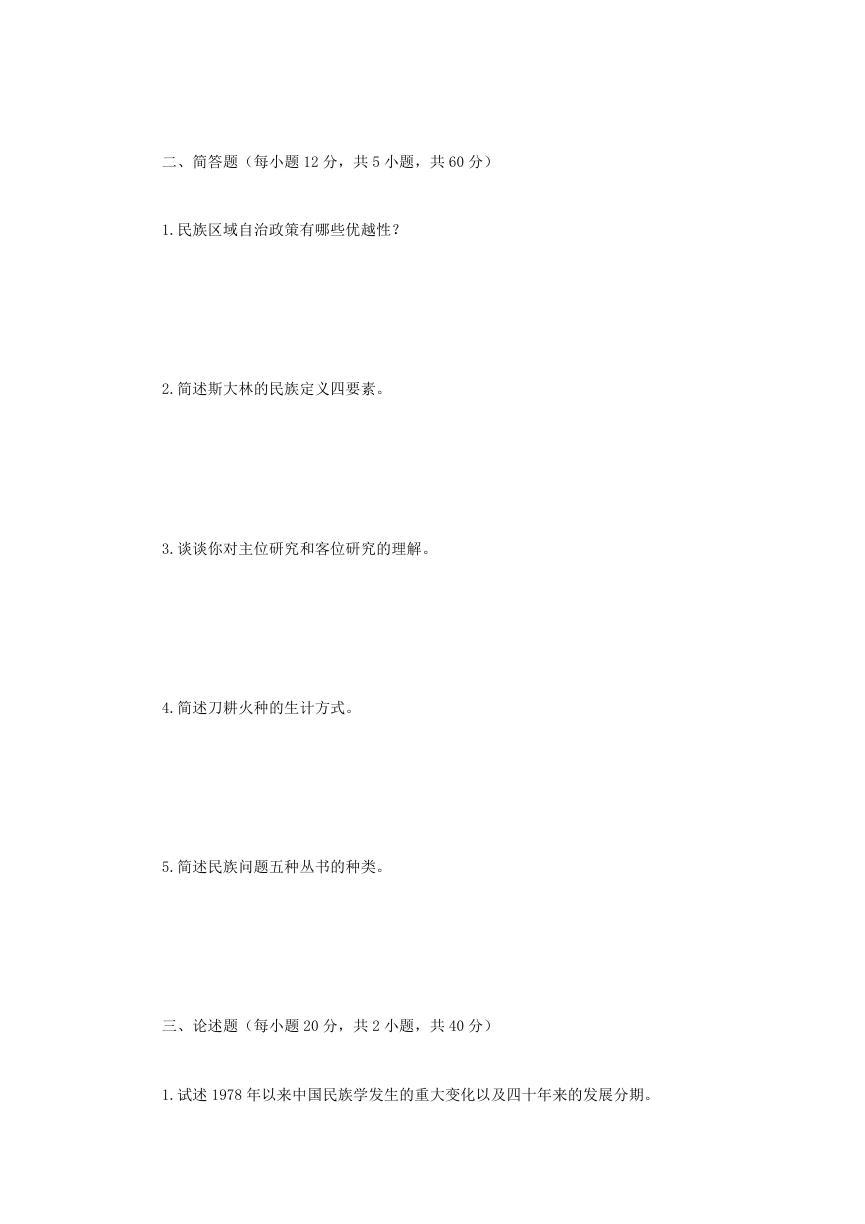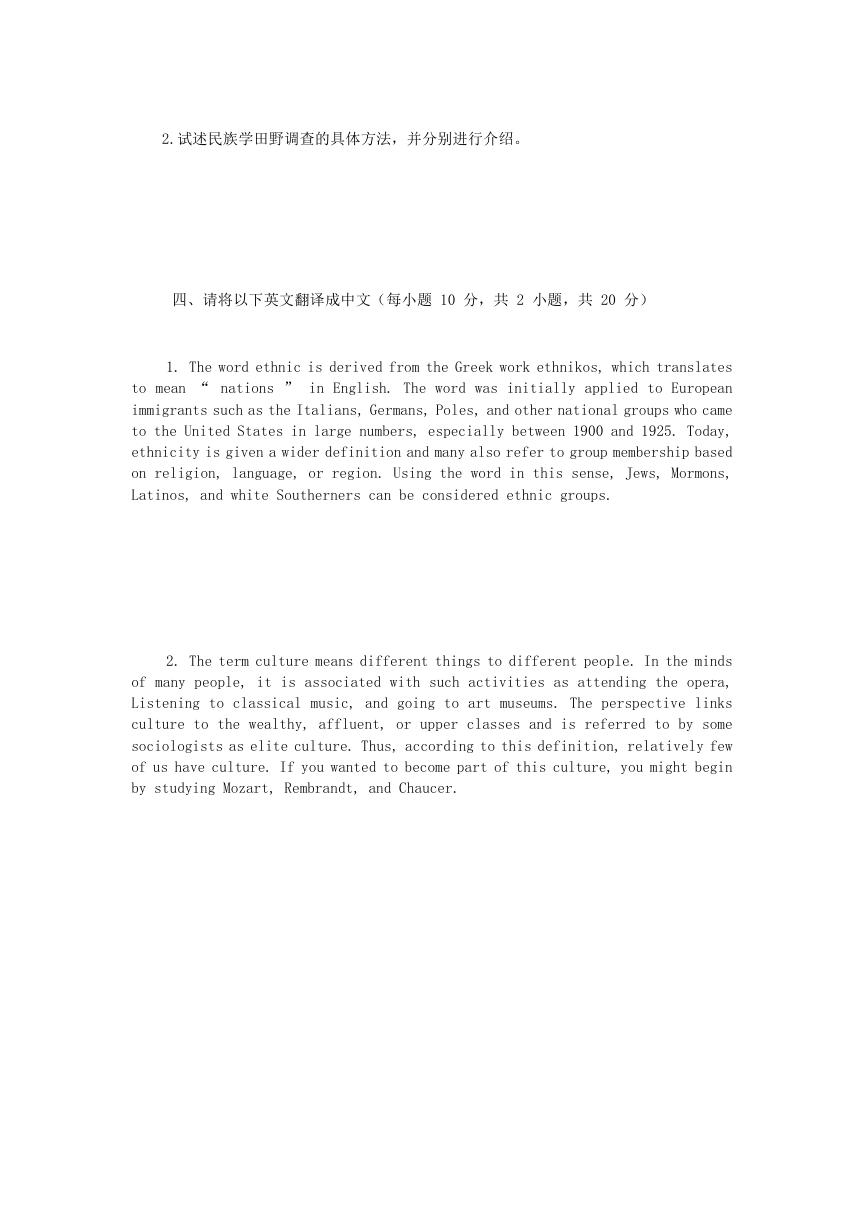2019 年广西民族大学综合考试考研真题 A 卷
一、名词解释(每小题 5 分,共 6 小题,共 30 分)
1.石牌制
2.《文化模式》
3.民族识别
4.干栏建筑
5.图腾崇拜
6.追踪调查
�
二、简答题(每小题 12 分,共 5 小题,共 60 分)
1.民族区域自治政策有哪些优越性?
2.简述斯大林的民族定义四要素。
3.谈谈你对主位研究和客位研究的理解。
4.简述刀耕火种的生计方式。
5.简述民族问题五种丛书的种类。
三、论述题(每小题 20 分,共 2 小题,共 40 分)
1.试述 1978 年以来中国民族学发生的重大变化以及四十年来的发展分期。
�
2.试述民族学田野调查的具体方法,并分别进行介绍。
四、请将以下英文翻译成中文(每小题 10 分,共 2 小题,共 20 分)
1. The word ethnic is derived from the Greek work ethnikos, which translates
to mean “ nations ” in English. The word was initially applied to European
immigrants such as the Italians, Germans, Poles, and other national groups who came
to the United States in large numbers, especially between 1900 and 1925. Today,
ethnicity is given a wider definition and many also refer to group membership based
on religion, language, or region. Using the word in this sense, Jews, Mormons,
Latinos, and white Southerners can be considered ethnic groups.
2. The term culture means different things to different people. In the minds
of many people, it is associated with such activities as attending the opera,
Listening to classical music, and going to art museums. The perspective links
culture to the wealthy, affluent, or upper classes and is referred to by some
sociologists as elite culture. Thus, according to this definition, relatively few
of us have culture. If you wanted to become part of this culture, you might begin
by studying Mozart, Rembrandt, and Chaucer.
�






 2023年江西萍乡中考道德与法治真题及答案.doc
2023年江西萍乡中考道德与法治真题及答案.doc 2012年重庆南川中考生物真题及答案.doc
2012年重庆南川中考生物真题及答案.doc 2013年江西师范大学地理学综合及文艺理论基础考研真题.doc
2013年江西师范大学地理学综合及文艺理论基础考研真题.doc 2020年四川甘孜小升初语文真题及答案I卷.doc
2020年四川甘孜小升初语文真题及答案I卷.doc 2020年注册岩土工程师专业基础考试真题及答案.doc
2020年注册岩土工程师专业基础考试真题及答案.doc 2023-2024学年福建省厦门市九年级上学期数学月考试题及答案.doc
2023-2024学年福建省厦门市九年级上学期数学月考试题及答案.doc 2021-2022学年辽宁省沈阳市大东区九年级上学期语文期末试题及答案.doc
2021-2022学年辽宁省沈阳市大东区九年级上学期语文期末试题及答案.doc 2022-2023学年北京东城区初三第一学期物理期末试卷及答案.doc
2022-2023学年北京东城区初三第一学期物理期末试卷及答案.doc 2018上半年江西教师资格初中地理学科知识与教学能力真题及答案.doc
2018上半年江西教师资格初中地理学科知识与教学能力真题及答案.doc 2012年河北国家公务员申论考试真题及答案-省级.doc
2012年河北国家公务员申论考试真题及答案-省级.doc 2020-2021学年江苏省扬州市江都区邵樊片九年级上学期数学第一次质量检测试题及答案.doc
2020-2021学年江苏省扬州市江都区邵樊片九年级上学期数学第一次质量检测试题及答案.doc 2022下半年黑龙江教师资格证中学综合素质真题及答案.doc
2022下半年黑龙江教师资格证中学综合素质真题及答案.doc